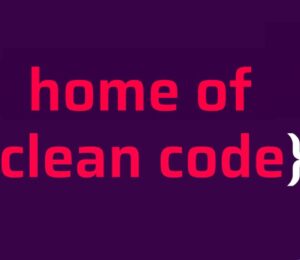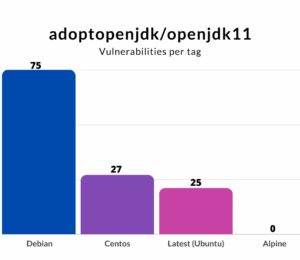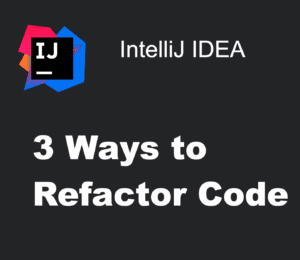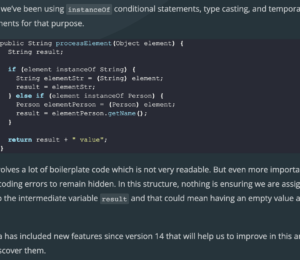Builders, Withers, and Records: Java’s path to immutability
- February 28, 2024
- 10981 Unique Views
- 6 min read
We know that immutable objects are easier to maintain, lead to fewer errors, and are multi-thread friendly. In this article, I will talk about two different approaches in Java to creating objects: Builders and Withers, typically used in the context of immutable objects, along with a new type of immutable object in Java: Records.
When it comes to creating objects in Java, we can use fluent approaches, especially for complex objects containing lots of fields, that will increase readability and also adaptability allowing us to evolve the code with lower impact on the existing code. And we want to because fluent code is both easier to read and easier to write.
We also know that immutable objects are easier to maintain, lead to fewer errors, and are multi-thread friendly.
In this article, I will talk about two different approaches to creating objects: Builders and Withers, typically used in the context of immutable objects, along with a new type of immutable object in Java: Records.
JavaBean pattern
The usual way of defining classes in Java follows the JavaBean pattern. This involves using a default constructor with no arguments, and accessors and mutators for properties.
public class Person {
private int age;
private String name;
public int getAge() {
return age;
}
public String getName() {
}
public void setAge(int age) {
this.age = age;
}
public void setName(String name) {
this.name = name;
}
}
Person person = new Person();
person.setAge(15);
person.setName("Antonio");
This approach implies that the state of the object can be “unsafe” as we could create an instance of Person without specifying any mandatory and key values. It even allows mutating the object during its lifetime, potentially making the system less safe, especially with multithreaded approaches. Immutability brings a lot of benefits.
The path to immutability and a safe state
So, the next step in order to fix this issue would be to create a constructor with the mandatory and key properties, and not expose mutators (setters) for them.
public class Person {
private int socialNumber;
private String name;
private String address;
public Person(String name, int socialNumber) {
if (name == null || name.isBlank())
throw new IllegalArgumentException();
this.name = name;
this.socialNumber = socialNumber;
}
public int getSocialNumber() {
return socialNumber;
}
public String getName() {
}
public void setAddress(String address) {
this.address = address;
}
public String getAddress() {
return address;
}
}
Person person = new Person("Antonio", 1566778890);
person.setAddress("Barcelona");
With this approach though, we face potential issues in terms of readability and adaptability when the class grows into a more complex definition.
public Person(String name, int age, String id, String phoneNumber, String email, Person parent1, Person parent2) { ... }
Person person = new Person("Antonio", 15, 1445678, "+34 666 77 88 99", "[email protected]", juan, carla);
In case we add more mandatory properties, as we see above, we need to add more parameters to the constructor and this will impact the existing code making us modify it on every call to the constructor.
Considering mandatory and optional arguments, for immutable objects, we can run into the “telescoping constructors” problem where we need to create several constructors considering the different nullability combinations.
public Person(String name, int age, String id, String phoneNumber, String email, Person parent1, Person parent2) {...}
public Person(String name, int age, String id, String phoneNumber, String email, Person parent1,) {...}
public Person(String name, int age, String id, String phoneNumber, String email) {...}
public Person(String name, int age, String id, String phoneNumber) {...}
The Builder approach
To fix this we can use Builders, which will help with readability and also on future changes making it easier to add the new properties.
First let’s remove any mutator, leave the accessors, and make it “impossible” to create a new instance with a constructor.
public class Person {
private String name;
private int socialNumber;
// Invisible constructor
private Person() {
}
public String getName() {
return this.name;
}
public int getSocialNumber() {
return this.socialNumber;
}
@Override
public String toString() {
return "Person [name=" + name + ", socialNumber=" + socialNumber + "]";
}
}
Now we will add the inner class in charge of building the new instance and a new method that invokes the Builder.
// inside Person class
// Fluent Builder API
public static PersonBuilder builder() {
return new PersonBuilder();
}
public static class PersonBuilder {
private String name;
private int socialNumber;
PersonBuilder() {
}
public PersonBuilder name(String name) {
this.name = name;
return this;
}
public PersonBuilder socialNumber(int socialNumber) {
this.socialNumber = socialNumber;
return this;
}
public Person build() {
// Validations
if (name == null || name.isBlank()) {
throw new IllegalArgumentException();
}
// Build
Person person = new Person();
person.name = name;
person.socialNumber = socialNumber;
return person;
}
}
And with this approach now we are able to create a new immutable instance with a validated state.
Person person = Person.builder()
.name("Antonio")
.socialNumber(15546464564)
.build();
The above approach includes a lot of boilerplate code that can discourage us from using it. To make things easier we can use libraries with annotations that will generate the code for us: Immutables, Lombok, Auto, FreeBuilder, etc.
@lombok.Builder
public class Person {
private String name;
private int socialNumber;
}
Person person = Person.builder().name("Antonio").socialNumber(2023452).build();
The Wither approach
Another approach to having a fluent API and immutability is the usage of “withers”, or with* methods, that create a new instance on every property change.
The idea behind it is that every mutator creates a new object instance, and we can chain those calls in order to produce complete instances.
// inside Person class
// remove setters
public Person(String name, int age) {
if (name == null) throw new NullPointerException("name");
this.name = name;
this.age = age;
}
public Person withName(String name) {
if (name == null) throw new NullPointerException("name");
return (this.name == name) ? this : new Person(name, age);
}
public Person withAge(int age) {
if (age < 0) throw new IllegalArgumentException("age");
return (this.age == age) ? this : new Person(name, age);
}
We can consume this approach like this, making it very easy to apply small changes to an existing object by obtaining a new object. We are “cloning” the object and changing one property at a time.
Person person = new Person("Luis", 45);
Person person2 = person.withName("Jose");
// here we have person2 = Jose, 45
Again in order to reduce boilerplate code, and be less error-prone, we can leverage existing libraries with annotation processors that will make the process smoother and cleaner.
public class Person {
@lombok.With @NonNull private final String name;
@lombok.With private final int age;
public Person(@NonNull String name, int age) {
this.name = name;
this.age = age;
}
}
The main drawback to the Withers approach is that we rely a lot on the garbage collector in order to remove intermediary objects, especially when we chain Withers:
person.withName(“John”).withAge(50)
Those objects are not used in the end and we will need to wait for the garbage collector to remove them. This can impact performance in systems with high object creation rates.
Records
Finally, the language itself, since Java 16, provides a struct definition called Records, which is focused on immutability, mainly to store data values, reduce boilerplate code, and increase readability. With Records, we can be sure our objects are immutable as they don’t provide mutators, only accessors, and fields are final.
So in our case, our Person class could be defined as:
record Person(String name, int age) {}
...
Person person = new Person("Pedro", 66);
This would end up in the same code for Person as we had at the beginning of this article, removing the setters and making all fields final.
Some creational issues are not solved out of the box with Records, like the mandatory/optional fields and the constructor, and it’s not easy to create new objects based on existing ones, but we can rely on libraries like RecordBuilder to help us with that.
// Builder
@RecordBuilder
public record Person(String name, int age){}
Person person = PersonBuilder.builder().name("Jose").age(89).build();
// Wither
@RecordBuilder
public record Car(String brand, String model, int year) implements CarBuilder.With{}
Car car = new Car("Seat", "Ibiza", 2015);
Car car2 = car.withModel("Cordoba");
Despite these issues, Records are a great solution for representing data with immutable state, while also reducing the boilerplate code in order to define the structures.
Conclusions
Immutability is a concept that will provide many benefits to our code, like predictability, easy testing, thread safety, and others that will impact our code’s intentionality, consistency, adaptability, and responsibility.
In order to achieve immutability, we have different options like Builders, Withers, or the use of Record type, but ultimately, the choice between Builders and Withers depends on the specific requirements of your application and the design principles you want to follow.
Builders are often preferred for complex object creation with many optional parameters, while withers can be more suitable for modifying existing immutable objects. If you are on Java 16 or above, consider that the use of Records is recommended over ordinary classes as they are immutable per definition.
Remember that SonarLint, SonarQube, and SonarCloud with their Java analyzer will help you deliver clean code with a long list of rules to consider when you code.
Don’t Forget to Share This Post!












Comments (4)
Nat Mishkin
2 years agoCoincidentally and apropos of this post, just yesterday I read and noticed a relevant JEP: https://openjdk.org/jeps/468 ("Derived Record Creation"). That (or something like it) would be a great addition to Java.
Java Weekly, Issue 532 | Baeldung
2 years ago[…] >> Builders, Withers, and Records: Java’s path to immutability [foojay.io] […]
Ruslan
2 years agoThank you for the article! You described the real problems with immutable java classes. We need builders and withers to made their usage convenient, and we do not have anything out of the box in Java language to do this. I fully agree. Then you described Lombok as one of the solutions to greatly reduce the boilerplate. I agree with this part too. But then you put Records to the table. But you literally showed that they do not solve any of these problems. You still need an annotation processor to add Builders and Withers. You still have a problem with creating too many objects in memory (and relying on the GC to collect them) if withers will be used generously. The only problem records solve is: they reduce the boilerplate of fields/getters/equals/hashCode definition, and also they are immutable by default (but I don't think this could be considered as a big advantage, as it's not that hard to just use `final` in normal classes). But, if we need to use an annotation processor anyway (to add builders/withers), then we could just use the same annotation processor to add getters/equal/hashCode, so this devalues the advantage of using records. Moreover, records force us to use a naming pattern that violates JavaBeans standard. While I personally like the pattern, it directly conflicts with many libraries that was written during last 20 years and expect objects to follow JavaBeans standard. This makes records hard to use in some cases. This also diversifies standards and adds cognitive problems of usage of classes/records. Each time you need to check what method you should call on e.g. `author` object: is this `getName()` or `name()`? Before records it was `getName()` in 99% of the cases. So, cosidering how little advantages records give (+ disadvantages they bring), I'm not sure they should be considered as a default solution for your immutable classes even if you use Java 16+. I remember even Brian Goetz (the main author of Java records) said somewhere that they are not intended to be used instead of immutable classes ubiquitously. E.g. if you see a necessity to add some logic to the record, then it probably a signal that you should use a class instead. Overall, good article that shows problems of creating immutable objects with Java language, but I disagree with the conclusion, especially this part: "the use of Records is recommended over ordinary classes as they are immutable per definition". Especially when we are talking not only about dumb data-classes (data containers without any logic).
Jonathan Vila
2 years agoThank you a lot @Ruslan for your comment. With Records what we have is a consistent way to define an immutable (shallow) object. In order to create Builders or Withers for Records you can add them manually. But if you decide to use processors, I don't see what would be the value to add getters/equal/hashCode as they already exist in the Record. Regarding using final in regular classes, sure, but from the reader's perspective it's way clearer to know that the class is immutable if they know it's a Record. Regarding the naming pattern violation, you are right that this can impact the usage of third party libraries. I'm sure they will evolve and adopt Records, but in the meantime you definitely have to consider this and not use Records if that's the case. Regarding the usage of Records, I totally agree with you. They are not intended to be used everywhere, especially if you need logic for those classes. With the conclusion, Records by themselves are not the ones bringing disavantadges, but the other libraries design. So, when having data objects I think the Record pattern is the one to go. Although, as you also pointed very well, we need to consider the reality of our system and decide the impact and benefits.